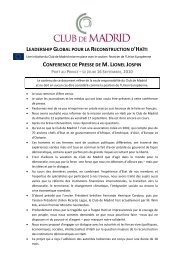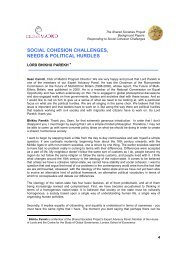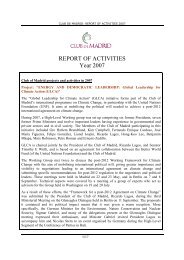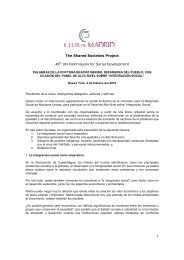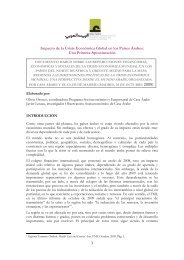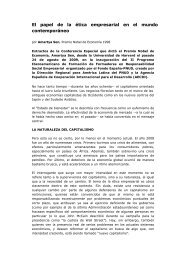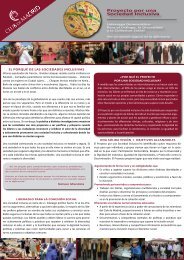Investing cultural diversity and intercultural dialogue - Business and ...
Investing cultural diversity and intercultural dialogue - Business and ...
Investing cultural diversity and intercultural dialogue - Business and ...
Create successful ePaper yourself
Turn your PDF publications into a flip-book with our unique Google optimized e-Paper software.
20 . PART II – KEY VECTORS OF CULTURAL DIVERSITY<br />
Policies fostering <strong>cultural</strong> <strong>diversity</strong><br />
Policies aiming to foster <strong>cultural</strong> <strong>diversity</strong> in communi -<br />
cation <strong>and</strong> <strong>cultural</strong> content contribute to the flourishing<br />
of pluralism <strong>and</strong> the free flow of ideas. Cultural <strong>diversity</strong><br />
must therefore lie at the core of quality media. Large<br />
segments of the population, such as marginalized<br />
groups <strong>and</strong> ethnic minorities, are often absent from the<br />
media, in part because of their lack of access to editorial,<br />
managerial or gate-keeping positions within media<br />
outlets. Fostering internal <strong>diversity</strong> in the newsroom, <strong>and</strong><br />
a <strong>diversity</strong> of <strong>cultural</strong> backgrounds <strong>and</strong> gender within<br />
media structures, are fundamental to ensuring <strong>diversity</strong><br />
of content.<br />
To this end, the potential of new media practices <strong>and</strong><br />
user-generated content should also be harnessed.<br />
Innovative journalism practices are emerging, for<br />
example, through mobile-device-based video-reporting.<br />
Hybrid reporting across <strong>cultural</strong> <strong>and</strong> national boundaries<br />
– through co-production <strong>and</strong> pool-production schemes<br />
or through national, regional <strong>and</strong> international networks<br />
of media professionals – are being tested <strong>and</strong><br />
encouraged. The Internet offers the potential to support<br />
communicational democracy through a range of<br />
progressive <strong>cultural</strong> initiatives that bypass mainstream<br />
information sources: identity-building within diasporic<br />
communities; support structures defending the interests<br />
of minority cultures; online communities, activist groups<br />
<strong>and</strong> people with shared <strong>cultural</strong> interests.<br />
Three challenges must be met if communication <strong>and</strong><br />
<strong>cultural</strong> content is to contribute to <strong>cultural</strong> <strong>diversity</strong>:<br />
those represented by the requirements of innovative<br />
content, exp<strong>and</strong>ed access <strong>and</strong> balanced representation.<br />
The production of innovative content ensures the<br />
integration of <strong>cultural</strong> <strong>diversity</strong> into the media <strong>and</strong> the<br />
<strong>cultural</strong> industries, together with a strong emphasis on<br />
local content. Access involves among other things<br />
coherent measures to reduce the digital divide,<br />
accessibility of production <strong>and</strong> distribution to innovative<br />
content, <strong>and</strong> encouragement of new information <strong>and</strong><br />
communication strategies by ensuring that opposing<br />
viewpoints are represented in discussions on all subjects.<br />
Cultural <strong>diversity</strong> likewise dictates a balanced<br />
representation of the different communities living<br />
together in a particular country, in accordance with the<br />
principles of the freedom of expression <strong>and</strong> the free flow<br />
of ideas.<br />
Artistic creation <strong>and</strong><br />
all forms of<br />
innovation<br />
spanning the<br />
spectrum of human<br />
activity may be seen<br />
as primary sources<br />
of <strong>cultural</strong> <strong>diversity</strong><br />
L Russian matrioshka dolls<br />
Chapter 6: Creativity <strong>and</strong> the<br />
marketplace<br />
This chapter considers the interrelations between<br />
<strong>cultural</strong> <strong>diversity</strong> <strong>and</strong> a broad spectrum of activities<br />
extending from <strong>cultural</strong> creation through the<br />
commercialization of <strong>cultural</strong> expressions to the broader<br />
impacts of culture on business <strong>and</strong> the marketplace.<br />
Underlying the phenomenon of globalization, the<br />
creative impulse at the root of <strong>cultural</strong> <strong>diversity</strong> is key to<br />
the analysis of the present situation of the world’s<br />
cultures. Indeed, <strong>cultural</strong> <strong>diversity</strong> can only be preserved<br />
if its roots are constantly nourished by innovative<br />
responses to a rapidly evolving environment. In this<br />
sense, artistic creation <strong>and</strong> all forms of innovation<br />
spanning the spectrum of human activity may be seen<br />
as primary imaginative sources of <strong>cultural</strong> <strong>diversity</strong>.<br />
Creativity is thus fundamental to <strong>cultural</strong> <strong>diversity</strong>, which<br />
is itself conducive to creativity.<br />
Artistic creation <strong>and</strong> creative economy<br />
It is important to avoid an ethnocentric conception of<br />
creativity. Rather, creativity should be understood to<br />
encompass all the material productions by which human<br />
beings give meaning to their existence. The boundaries<br />
of ‘art’ vary considerably from one culture to another,<br />
reflecting divergences of outlook as well as the materials<br />
<strong>and</strong> techniques available to the societies concerned. The<br />
second half of the 20 th century has been marked by a<br />
radical diversification of tastes, venues <strong>and</strong> markets in<br />
the art world <strong>and</strong> the growth in artistic exchange<br />
worldwide. From the perspective of contemporary art<br />
practices, the world is moving towards forms of<br />
outwardness <strong>and</strong> is no longer structured in terms of the<br />
centre/periphery relation. This broadening of artistic<br />
outlooks <strong>and</strong> expressions has contributed to forms of<br />
cross-fertilization reflected in all forms of artistic creation.<br />
While <strong>cultural</strong> policy should be receptive to these cross<strong>cultural</strong><br />
influences, it should also recognize that such<br />
globalizing trends are not without their danger to<br />
<strong>cultural</strong> <strong>diversity</strong>. The borrowings or hybrid forms to<br />
which globalization gives rise can turn out to be little<br />
more than stereotypes, just as international markets for<br />
indigenous ‘exotic’ art can function as venues rewarding<br />
artistic conformism.<br />
The diversification <strong>and</strong> interpenetration of artistic<br />
traditions is reflected in the performing arts in<br />
substantive international exchanges in the spheres of



